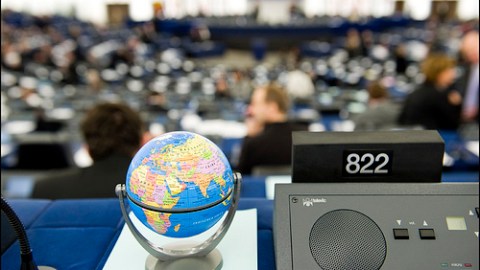The Cross-Atlantic Divergence on Climate Policy: Despite Similarities in Public Views, What Explains Differences in Government Action?

Commentators and advocates tend to argue that the Europe Union has taken the lead in climate policy in reaction to strong public demand across member states. Yet the reality, argues Melissa Johnson in a guest post today, is more complex than conventionally perceived. Johnson is a graduate student in in this semester’s “Science, the Environment, and the Media” course at American University — Matthew Nisbet.
Across many European Union countries, public opinion about climate change is remarkably similar to American opinion, yet at the policy level, the E.U. has taken the global lead over the past decade on policy action related to the issue. If governments are supposed to be responsive to their constituents, what explains the divergence in government action?
In a 2006 study analyzing public attitudes towards climate change in both the United States and Europe, researchers Irene Lorenzoni and Nick Pidgeon found that climate change is conceptualized by the public almost identically across countries examined, but generally takes a back seat as a policy priority to many other issues. While the majority of respondents in these studies believe climate change is a serious problem, it comes in behind family, health, safety, and finances as a top concern.
The ranking of these concerns also often shift related to major focusing events. Before September 11, 2001, 31% of Europeans rated the environment as the most important global problem, but a survey conducted in 2004 found that terrorism and domestic issues became a higher priority for the majority of respondents. Even among environmental issues, climate change was no longer viewed as the most important. A 2004 poll conducted in the U.K. placed climate change third behind water pollution and man-made disasters. Similarly, a poll conducted in the U.S. placed climate change ninth out of ten environmental problems. Lorenzoni and Pidgeon argue that this is a result of media attention defining these other environmental issues as public health risks while climate change remained defined exclusively as an environmental threat.
Knowledge of climate change is also severely lacking across all countries. In a survey conducted in 1999, only a small fraction of respondents, 17% in Finland compared to 11% in the U.S., could correctly identify the burning of fossil fuels as the main anthropogenic cause of climate change. In fact, 26% of respondents believed the cause to be the depletion of the ozone layer, which further demonstrates a grim misunderstanding of the phenomenon.
A European Union Less Responsive to Public Opinion
These findings are notable for the contradiction that is exposed when observing the relationship between the perceived priority of the issue by the public and the commitments of their government representatives to policy action. In the U.S., public interest in and awareness of climate change lags well behind the severity of the issues at stake and policy on a national level seems to be following this trend. Dan Kelemen and David Vogel have tracked this decline in U.S. support for international environmental policy following the golden years of U.S. leadership in this field. While Kelemen and Vogel argue that the potentially harmful effects from international environmental regulations on domestic producers were the cause for this shift, I am inclined to agree with Michael Pulia who in a paper argues that public opinion is responsible.
Policymakers in the U.S. care very much about the views that their constituencies hold and will spend the entirety of their time in office either working towards promises made to constituents on the campaign trail, or working to appease constituents with the goal of reelection on the near horizon. Pulia backs this theory by arguing that support for the environment peaked in the U.S. in the early 1990s, and at the time the government responded enthusiastically by passing numerous environmental initiatives. After a major decrease in public support in 1995, however, commitment by policymakers ebbed considerably.
In contrast to the strong constituent focus of American elected officials, scholars argue that European citizens do not have access to members of the European Parliament stationed in Brussels and Strasbourg, and they are therefore not able to influence the political process as strongly as U.S. citizens do. Additionally, other characteristic of the E.U. as an institution lends itself to holding little accountability for the decisions taken. Consequently, E.U. officials pursue policy goals with less concern for where these goals might fall among the perceived priorities of constituents across member states. If this unique institutional arrangement did not exist, would policy action in the E.U. be equivalent to the level of (in)action in the United States?
Instead of public pressure, scholars argue that E.U action on climate change was primarily influenced by the strength of environmental groups and political parties such as the Green party. Keleman and Vogel argue that the strength of these groups in Europe emerged from the grassroots environmental movement of the 1980s when public attention was focused on issues such as Chernobyl and the ozone layer. Environmental groups continue to gain traction through the rise of Green parties even after public support had waned. The emergence of Green parties is key as they became mainstream in national coalition governments by the 1990s and had greater influence on both the domestic priorities of member states and the supranational priorities of the E.U. Keleman and Vogel see the mid-1990s as a turning point for international leadership on climate change as the U.S. separated itself from international regulation and the E.U. stepped in to take its place.
–Guest post by Melissa Johnson, a MA student in the Global Environmental Politics Program in the School of International Service at American University.
This post is part of the course “Science, Environment, and the Media” taught by Professor Matthew Nisbet in the School of Communication at American. See also other posts on the climate change debate by Ms. Johnson and members of her project team.





